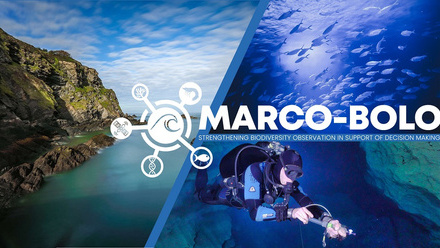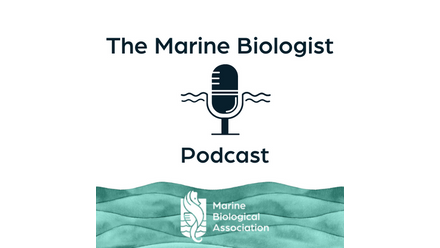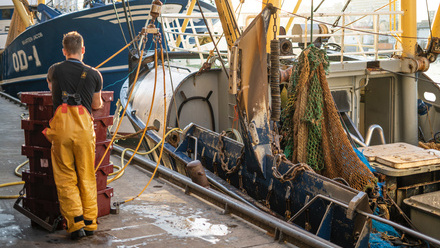SCIENCE DIPLOMACY IN THE SOUTH CHINA SEA
Main image: A healthy coral reef off Malaysia. © Sylvia Jagerroos.
In the cerulean depths of the South China Sea, coral reefs rise like submerged cathedrals—elaborate, living architectures built not of stone, but of calcium carbonate and time. These ecosystems, some millennia in the making, harbour a symphony of biodiversity: reef-building corals, reef fish, molluscs, echinoderms, and countless microbial partners in an intricate web of life. But that natural wealth is under siege.
Satellite images and scientific studies paint a grim picture as human activities take a steep toll: the seascape of the South China Sea has become a sprawling environmental crime scene, marked by the destruction of once-thriving coral reefs now reduced to lifeless debris. What’s unfolding beneath the waves is not just an environmental crisis—it’s a regional and global emergency. Without immediate action, we risk losing one of Earth’s last great marine reservoirs of life.
These visual and scientific records serve as a sobering reminder of the fragility of marine environments in the face of geopolitical ambition and unsustainable practices. As pressure mounts on the South China Sea’s ecosystems, the urgency for coordinated conservation, sustainable marine management, and science-based policy intervention becomes increasingly clear.
This ecological devastation stems largely from the aggressive actions undertaken by claimant nations such as China, Vietnam, Malaysia, and Taiwan, who have transformed fragile marine ecosystems into militarized zones through large-scale land reclamation projects. These activities involve dredging, island building, and infrastructure development that inflict long-term damage on biodiversity and accelerate the decline of coral ecosystems that are already under threat from climate change and pollution. According to the Asia Maritime Transparency Initiative, island-building in the South China Sea has destroyed more than 2,500 hectares of coral reefs.
Marine scientists call for ‘blue parks’
In response to these escalating environmental threats, a growing emphasis on environmental security—viewed through the lens of scientific research and conservation—has begun to reshape the discourse around the South China Sea. Scientists, environmentalists, and policymakers are highlighting the urgent need to protect this ecologically vital region by advocating for the establishment and expansion of marine protected areas, often referred to as ‘blue parks’.
These protected marine reserves aim to preserve biodiversity, restore damaged ecosystems, and create buffers against geopolitical conflict by prioritizing ecological stewardship. The growing momentum behind these initiatives signals a potential shift from conflict-driven exploitation to science-informed conservation, offering a more sustainable path forward for this strategically and ecologically significant maritime region.
The High Seas Treaty, adopted in 2023 to safeguard marine biodiversity beyond national jurisdictions, provides a legal framework that could bolster the creation of networked marine protected areas in the contested South China Sea—offering a collaborative, science-based approach to conservation in a region fraught with geopolitical tensions. By enabling multilateral governance over shared ecosystems, the treaty may help transcend sovereignty disputes and foster regional cooperation on environmental stewardship.
"Marine reserves aim to ... create buffers against geopolitical conflict by prioritizing ecological stewardship"
Claimant nations are increasingly taking action to integrate science with policy as they navigate the complex and often volatile geopolitics shaped by environmental change.
Vietnam, a claimant in the South China Sea and also involved in land reclamation, is taking steps to address environmental challenges by expanding its marine protected area programme. A notable example is Cu Lao Cham, a vibrant ecological site located about 20 kilometres off the central coast. Spearheaded by Professor Chu Manh Trinh, a biologist from Da Nang University, the area’s conservation efforts gained international recognition when it was designated a UNESCO World Biosphere Reserve in 2009 for its ecological and cultural importance.
Marine protected areas (MPAs) in the South China Sea are sparse and fragmented due to ongoing geopolitical tensions. While countries like the Philippines, Malaysia, and Vietnam have established national MPAs within their own exclusive economic zones (EEZs), there is no regional or transboundary conservation effort. Disputes over territories, especially around the Spratly and Paracel Islands, hinder collaboration. Despite these challenges, successful examples like the Tubbataha Reefs Natural Park in the Philippines, a UNESCO World Heritage site, show the potential for effective marine conservation in the region.
Although China’s artificial island building accounts for nearly two-thirds of the damage to marine habitats in the South China Sea, it has established over 270 marine protected areas, reflecting a growing commitment to marine conservation. This expansion signals a shift toward science based policymaking and a recognition of the need to protect biodiversity amid threats like overfishing, pollution, and climate change.
These MPAs are crucial for the conservation of marine biodiversity in the South China Sea, providing habitats for numerous marine species, including endangered sea turtles and dolphins. However, they also face challenges from overfishing, illegal harvesting, and environmental degradation due to human activities. Strengthening enforcement and expanding conservation efforts are essential to ensure the long-term health and sustainability of these marine ecosystems.
Marine scientists across the region are acutely aware that the continued degradation of coral reef ecosystems is driving a decline in fish stocks, with serious implications for food security among all nations with territorial claims in the South China Sea.
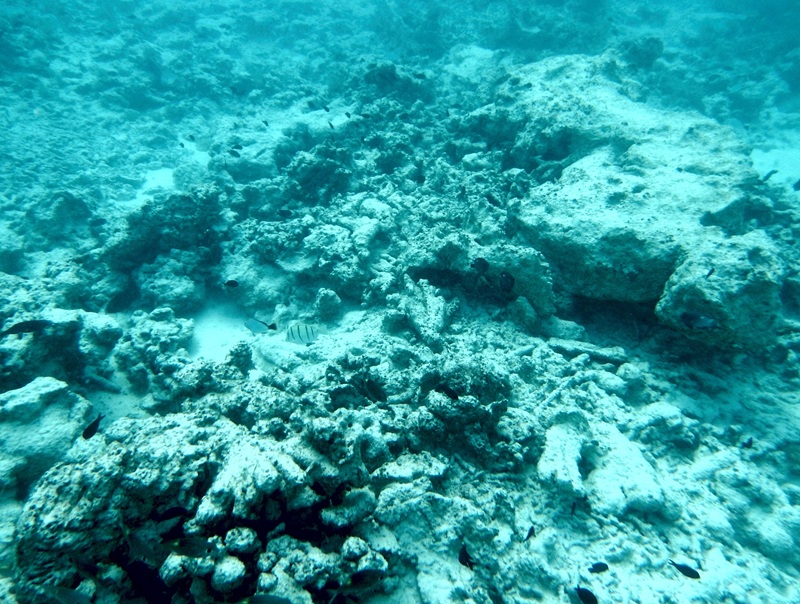
Above: Destroyed coral in the Spratly Islands, 2016. © John McManus.
Professor John McManus, a marine biologist from the University of Miami, has conducted underwater surveys in the Spratly Islands since the early 1990s. He and other scientists estimate it could take 10–20 years for damaged reefs to recover, as dead coral must first stabilize before new growth can occur.
The evidence is unequivocal: the ongoing depletion of marine resources in the Spratly and Paracel Islands constitutes a collective threat—one that transcends borders and demands coordinated scientific and policy responses. Without immediate and collective action, one of the world’s most important marine ecosystems may be pushed beyond the point of recovery.
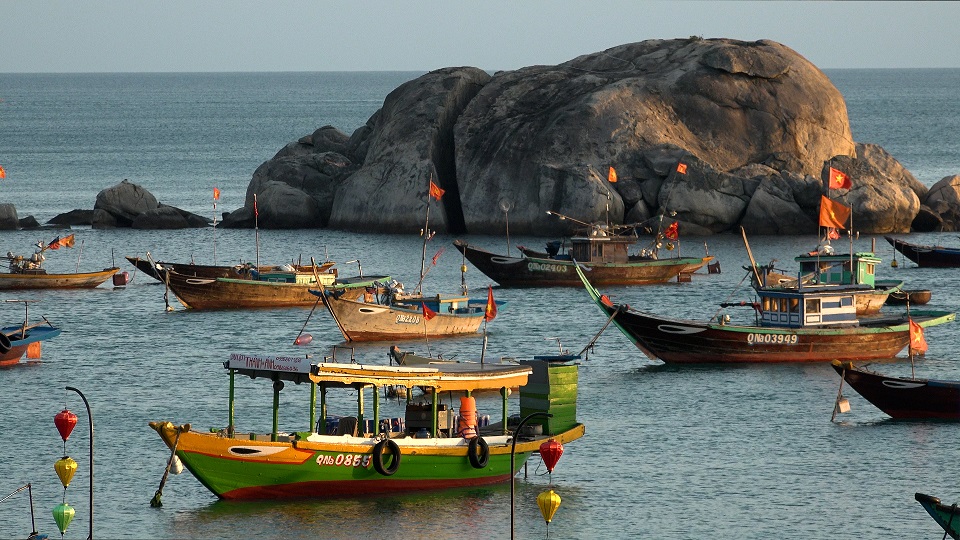
Above: Vietnamese trawlers in Cu Lao Cham, where the fishing is good. © David Monk.
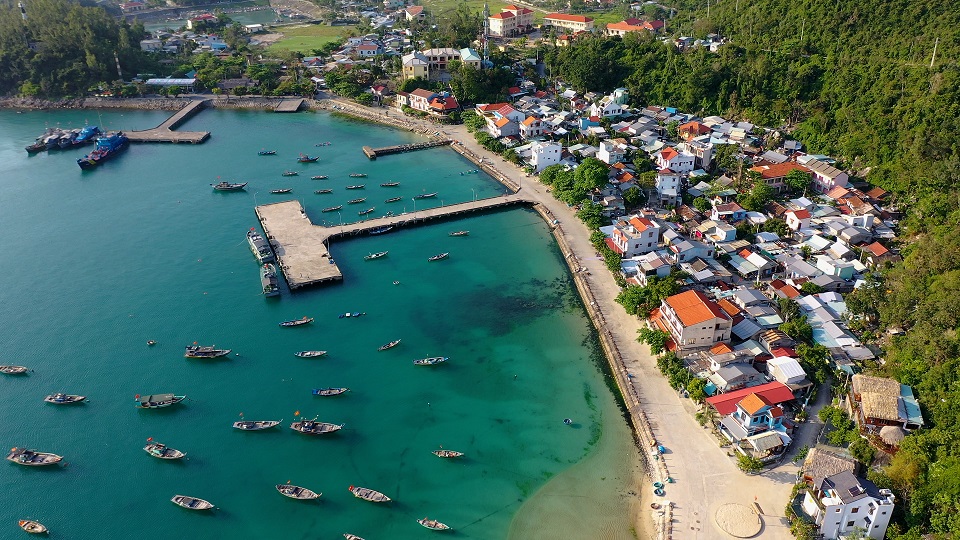
Above: Drone overview of Cu Lao Cham, a model marine protected area off Vietnam’s central coast. © David Monk.
Scientific and policy cooperation required
It is time to convene leading scientists with expertise in marine biodiversity and environmental sustainability in the troubled waters of the South China Sea for a dedicated science policy forum. Their collaboration could lay the foundation for establishing a South China Sea International Science Commission. As more marine scientists engage in joint workshops and communicate through the universal language of science, they are encouraging governments to designate additional marine protected areas.
The ‘blue parks’ serve as models for how nations and communities can come together to safeguard biodiversity, even in regions marked by political tension. By focusing on shared ecological goals—such as preserving critical habitats, protecting endangered species, and ensuring the sustainability of fisheries—MPAs encourage collaboration based on mutual environmental interests rather than territorial claims. In doing so, they offer a practical framework for transcending geopolitical disputes, demonstrating that environmental stewardship can act as a unifying force.
Coral reefs are not confined by national borders—nor should their stewardship be. Transboundary scientific collaboration and marine protected areas are essential if we are to preserve these ecological treasures.
• James Borton (asiareview@yahoo.com), non-resident Senior Fellow at Johns Hopkins SAIS Foreign Policy Institute.
James Borton’s new book, Harvesting the Waves: How Blue Parks Shape Policy, Politics, and Peacebuilding, is out now. www.universal-publishers.com/book.php?method=ISBN&book=1599427745

